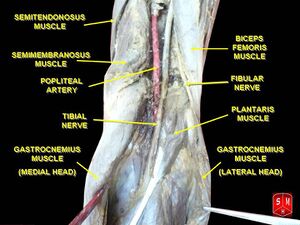Regio genus
Regio genus is a topographical landscape defined approximately by the extent of the knee joint (proximal three fingers above the base of the patella, distal to the level of tuberositas tibiae). It is divided into two landscapes: Regio genus anterior and regio genus posterior with fossa poplitea.
Regio genus anterior[edit | edit source]
The landscape on the front of the knee joint. The contents of the landscape are the knee joint.
The skin in the extent of the landscape is thick and well shifted, in the subcutaneous tissue there is the synovial bursa subcutanea praepatellaris and medially v. saphena magna together with the nerve saphenus, which is attached to it by the tendon of m. sartorius. Below the fascia lies the bursa subfascialis praepatellaris and below it the insertion tendon of m. quadriceps femoris, in which the patella is enclosed as a typical Sesame bone.Under the tendon on the proximal side is the recessus suprapatellaris. On the lateral side of the tibia is attached tractus illiotibialis (tuberositas tractus illiotibialis Gerdyi) and on the medial side pes anserinus - compound insertion of m. gracilis, m. sartorius and m. semitendinosus.
Palpable formations: Patella and ligamentum patellae, parts of femoral condyles, tibia and caput fibullae.
Fossa poplitea (Regio genus posterior)[edit | edit source]
Landscape boundaries[edit | edit source]
•Proximal, medially: m. semitendinosus, m. semimembranosus;
•proximal, lateral: m. biceps femoris;
•Distal al: M. gastrocnemius lateralis et medialis;
•The base of the landscape consists of M. popliteus and the knee joint. Under the tendrils of muscles, bursae are formed.
Content:[edit | edit source]
Neurovascular bundle consisting lateromedially and from the surface to the depth of n. fibularis communis (laterally at m. biceps femoris, then turns laterodistally around the caput fibulae, where it is often injured due to its superficial position), n. tibialis (runs through the middle of the landscape, runs between the abdomen of m. gastrocnemius), vasa poplitea (continuation of v. femoralis and A. femoralis, changes its name after passing through the hiatus adductorius), A. poplitea gives branches for surrounding muscles and joint. Along the vessels are deposited nodi poplitei. The space around the formations is filled with fatty tissue.
The skin of the landscape is delicate and shifting against the base, in the subcutaneous connective tissue runs v. saphena parva, which breaks through the fascia in the landscape and flows into v. poplitea. Fascia is solid in the landscape. Palpable are the attachments of the knee joint flexors: medially m. semitendinosus and semimembranosus, laterally m. biceps femoris clamping to the caput fibulae.
Links[edit | edit source]
Related Articles[edit | edit source]
Bibliography[edit | edit source]
- GRIM, Miloš – DRUGA, Rastislav, et al. Základy anatomie, 5.Anatomie krajin těla. 1. edition. Praha : Galén, 2002. 119 pp. pp. 96. ISBN 978-80-7262-179-8.

